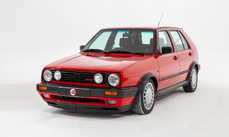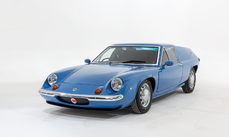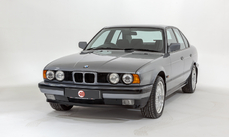Mercedes-Benz G-wagon 1993
General description :
Model History
The Mercedes-Benz G-Class, sometimes called the G-Wagen (short for Geländewagen – meaning “terrain vehicle”), is characterised by its boxy styling and body-on-frame construction. It uses three fully-locking differentials and is one of the few production vehicles to have such a feature. Despite the introduction of an intended replacement in 2006, the GL-Class, the G-Class remains in production to this day and is one of the longest produced vehicles in Daimler's history, with a span of 40 years – only the Unimog surpasses it.
Development of the G-Class started in 1972 with a cooperative agreement between Daimler-Benz and Steyr-Daimler-Puch in Graz, Austria. Mercedes-Benz engineers in Stuttgart were in charge of design and testing, while the team in Graz developed the production plans. Construction commenced in Graz, where the new cross-country vehicle would be assembled nearly entirely by hand in 1975, with production of the “G Model” beginning in Graz in 1979.
The first major refinements were introduced in 1981. These included an automatic transmission, air conditioning, an auxiliary fuel tank, protective headlamp grilles, and a cable winch. Fuel injection became available in 1982, when the 230GE was introduced in Turin, along with more comfortable and supportive front seats, auxiliary heating, wider tires and flared arches. For 1985, differential locks, central door locking, and a tachometer became standard, and by 1986 over 50,000 G models had been produced.
For 1990, the G-Class (W460/W461 chassis) was extensively revised, and a new chassis number – W463 – was assigned. The W463 moved the G-Class from a solely utilitarian vehicle to the luxury model we know today. Resultantly, no three-door panel vans or “barn door” variants were offered for W463; those features were exclusive to the W461.
The 1990 facelift included several exterior revisions for a more modern aesthetic. These features included a smoother front end with body-coloured headlamp bezels and grille, a form-fitted front bumper with integrated fog lamps, body-coloured wheel arch flares, the addition of a fuel filler flap, and revised rear lights. The interior was also significantly updated with wood trim and could be specified with leather upholstery for the first time. The centre console was smoothened out and better integrated with the dashboard, the electric differential lock switches were placed prominently in the middle of dash, and the instrument cluster met the dashboard more fluidly. The climate control panel was also revised to include the temperature and fan speed dials, and the seats were plusher with several defined cushions and lumbar support.
Updated specification included ABS and full-time four-wheel-drive with electrically locking differentials. The engines were carried over from the W460/W461 variants and included the 200GE, 230GE, and 300GE – as featured here.
Equipment
Brilliant Silver Metallic paintwork, Grey cloth upholstery, 18-inch AMG alloy wheels, G36 AMG badging, Air conditioning, ABS, Power steering, Electrically adjustable door mirrors, Electric windows front and rear, Driver and passenger front armrests, Pioneer CD player (not photographed), Folding rear seats, Rubber floor mats, Front and rear tow hooks, Heated rear window, Spare wheel with cover.
Exterior
This imposing G300 looks great in Brilliant Silver Metallic, its angular lines and wide arches helping to achieve a commanding presence on the road. At the front end there are almost no stone chips to be found, and the colour-coded bumpers are free from damage; the black waistline trim running the length of the vehicle is also in fine order. Looking along both sides the body panels are perfectly straight with even gaps to report. The light clusters are without any cracks or moisture ingress, and amazingly both the body and underside are entirely rust-free.
VIEWINGS WELCOME BY APPOINTMENT ONLY /// ADDITIONAL PHOTOS AVAILABLE UPON REQUEST
Interior
The interior is purposeful yet spacious and remains in good order throughout. The grey cloth upholstery has worn extremely well with no sagging or damage to the fabric, and the front seats boast individual armrests for added comfort. In the rear the legroom is particularly spacious for passengers; the seats can also be folded forward completely for a vast rear load capacity. The neutral interior is lifted with wood trim laced across the dashboard, centre console, doors panels, and steering wheel. The carpet is clean and protected in the footwells and boot area with the original plastic overmats.
ENGINE & TRANSMISSION
The G300 is equipped with the 3-litre M103 straight-six. The engine is mated with a four-speed automatic gearbox and three locking differentials, making this Mercedes a very capable off-road vehicle. We have just had the car freshly serviced, fully inspected and MOT’d for the new keeper’s peace of mind.
WHEELS, TYRES & BRAKES
The 18-inch AMG alloys look fantastic beneath the oversized arches. All wheels are in fine order with a smart polished lip and only minimal curb marking to be found. The wheels are shod in a matching set of Maxxis tyres with a good amount of tread remaining. Out on the road the braking system feels competent and strong, pulling the significant weight of the G-Wagen to a standstill quickly and smoothly.
History File
This W463 G300 was first registered in Japan in 1993. It arrived in the UK in 2014 but was soon exported to Spain when it sold to the current owner. The car has now arrived back with us and is available for sale once more, freshly serviced and inspected, with MOT until March 2021.
Having only ever resided on the salt-free roads of Japan and Spain, this particular G-Wagen boasts an amazing rust-free underside, especially when compared to the majority of UK/EU-supplied examples. The odometer reads just 148,190km, which equates to the low mileage of 92,081 miles.
http://www.4starclassics.com/for-sale/mercedes-g300-for-sale/
1993 Mercedes-Benz G-wagon is listed sold on ClassicDigest in Kingsley by 4 Star Classics for £24995.
Car Facts
Car type : Car Make : Mercedes-Benz Model : G-wagon Engine size : 3.0 Model Year : 1993 Sub type : Van Location : Hampshire
Sold
Seller Information
Sold
People who viewed this Mercedes-Benz G-wagon also viewed similar Mercedes-Benz listed at ClassicDigest
Other cars listed for sale by this dealer
About Mercedes-Benz
In the annals of automotive history, the journey of Mercedes-Benz is a tale that unfolds with the ingenuity of its founding pioneers. In the year 1886, Karl Benz crafted the Benz Patent Motorwagen, a creation that would go down in history as the world's inaugural automobile. Unbeknownst to him, this moment marked the genesis of what would evolve into the most illustrious premium car manufacturer globally. The financial underpinning of this pioneering venture, interestingly, was provided by Karl Benz's wife, Bertha Benz, demonstrating a remarkable partnership that would set the tone for Mercedes-Benz's legacy.A parallel narrative emerged not far away, as Daimler-Motoren-Gesellschaft, founded by Gottlieb Daimler and Wilhelm Maybach, entered the scene. In 1901, they unveiled their automobile under the now-famous moniker "Mercedes," meaning "godsend" in Spanish. This name was bestowed upon the car at the behest of Emil Jellinek's daughter, the distributor for Daimler-Motoren-Gesellschaft. The wheels of innovation were set in motion.
Fast forward to 1926, a pivotal year that witnessed the merger of Daimler with Benz & Cie., culminating in the birth of Daimler-Benz. The amalgamation saw the adoption of "Mercedes-Benz" as the distinguished trademark for their automobiles, fusing the legacies of two visionary entities into one.
Contrary to perceptions of conservatism, the trajectory of Daimler-Benz unfolds as a chronicle of industry firsts. From the introduction of the honeycomb radiator to the float carburetor, and the pioneering implementation of four-wheel brakes in 1924, Daimler-Benz consistently pushed the boundaries of automotive innovation. The diesel-powered Mercedes-Benz 260 D in 1936 marked the inception of diesel engines in passenger cars. The iconic Mercedes-Benz 300SL Gullwing made history as the first car with direct fuel injection, albeit the Gutbrod's tiny 2-stroke engine can claim precedence.
Safety innovations became a hallmark, with Béla Barényi's patented safety cell design in the "Ponton"-models in 1951, featuring front and rear crumple zones. The W116 450SEL 6.9 saw the introduction of the Anti-Lock Brake system (ABS), another pioneering safety feature. From the first production airbags and beyond, the legacy of "firsts" continued to be etched into the fabric of Daimler-Benz.
Over its centennial journey, Mercedes-Benz has not merely produced cars but has sculpted automotive icons. The SSKL, 710 SSK Trossi Roadster, 770K Grosser, 540K Spezial Roadster, 300SL Gullwing, w100 600 Pullman, w111 280SE 3.5 Flachkühler, w113 230SL Pagoda, w109 300 SEL 6.3, and w201 2.3-16 Cosworth stand testament to the brand's commitment to engineering excellence.
The roaring Silver Arrows, or "Silberpfeile," including the W 25, W 125, W154, W165, and W196, created a legacy of dominance on the racetrack. These machines were not merely cars; they were expressions of precision, speed, and an indomitable spirit that left their competitors in the dust.
As Mercedes-Benz marches into the future, it does so not just as an automaker but as a custodian of a legacy, a torchbearer of innovation, and a beacon of automotive excellence. The road ahead is sure to witness the continued fusion of cutting-edge technology, timeless design, and an unwavering commitment to setting new standards in the world of automobiles.
One luminary figure who left an indelible mark was Béla Barényi, often heralded as the "father of passive safety" for his pioneering work in safety engineering. His patented safety cell design, featuring front and rear crumple zones, became a hallmark of Mercedes-Benz's commitment to occupant safety, setting new standards that reverberated throughout the automotive world.
Moving through the chronicles, the collaborative genius of Wilhelm Maybach, alongside Gottlieb Daimler, laid the foundation for Daimler-Motoren-Gesellschaft. Their innovations not only birthed the first Mercedes but established a culture of relentless pursuit of technological excellence that remains integral to Mercedes-Benz's DNA.
In the post-merger era of 1926, Ferdinand Porsche emerged as a prominent figure within Mercedes-Benz. His work on the Mercedes-Benz S-Type, a supercharged race car, garnered acclaim and set the stage for a legacy that extended far beyond the marque. Porsche's impact would later extend to his eponymous company, but his influence at Mercedes-Benz during those formative years was pivotal.
As the 20th century progressed, the legendary Rudolf Uhlenhaut emerged as a key figure. Uhlenhaut, an accomplished engineer and the driving force behind the iconic Silver Arrows, played a crucial role in Mercedes-Benz's dominance in motorsports. His engineering prowess and attention to detail were instrumental in creating some of the most formidable racing cars of the era.
In the latter half of the century, figures like Bruno Sacco, the head of design at Mercedes-Benz from 1975 to 1999, left an indelible imprint on the brand's aesthetic identity. Sacco's design philosophy, characterized by clean lines and timeless elegance, shaped iconic models like the W126 S-Class and the W201 190E, solidifying Mercedes-Benz's reputation for luxury and sophistication.
The narrative would be incomplete without acknowledging the contributions of engineers like Hans Scherenberg, whose leadership in the 1970s ushered in a new era of technological innovation at Mercedes-Benz. Scherenberg's tenure saw the development of groundbreaking technologies, including the Anti-Lock Brake system (ABS) and the introduction of airbags in production cars.











